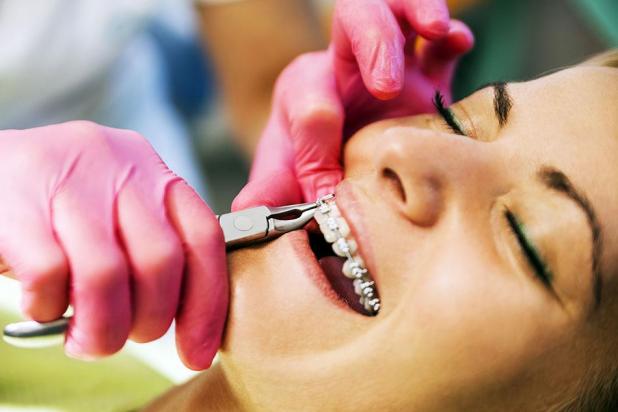
Braces consist of various components, all designed to put pressure on teeth so they move gradually.
How braces move teeth
Anyone with misaligned or crooked teeth may have considered orthodontic braces at some point. In fact, getting braces has now become a rite of passage for many youths.
The American Association of Orthodontics reports that roughly four million people are wearing braces at any given moment, and one in five of those people is an adult.
Orthodontists often share with their patients what to expect from their treatments, including how long they can expect to be in braces. While many know the basics of braces, they may be curious as to why braces are so effective.
Anyone who has had a tooth extraction knows that teeth don’t move around willingly, but they’re not cemented into the jaw, either.
In fact, teeth are held in place by what is known as the periodontal ligament. This ligament connects the roots of each tooth to the surrounding alveolar bone of the jaw that contains tooth sockets, explain the experts at Burke & Redford Orthodontics in Cali-fornia. The ligament is strong but it’s also malleable. This means that when pressure is applied for certain periods of time, teeth can move rather easily.
Braces consist of various components, all designed to put pressure on teeth so they move gradually.
Brackets are the metal or ceramic materials that are glued to the surface of the teeth. Archwires are fitted over the brackets and are the primary pressure-makers of the braces system. O-rings, also known as ligatures or ligature elastics, are small elastic bands that hold the bracket onto the archwire and will be changed at each adjustment, indicates Dillehay Orthodontics in Kansas.
When braces put pressure on the teeth, the periodontal membrane stretches on one side and compresses on the other, which essentially loosens the tooth in the socket. The orthodontist uses techniques and skill to manipulate each tooth into better position. This happens while the jaw bone grows in to support the tooth in its new position — called bone remodeling.
Some discomfort is to be expected during bone remodeling, but it’s usually a dull ache. It takes months for new tissue to come in while teeth move. Each patient is unique, but the process typically takes one to three years.
Patients are urged to wear a retainer following orthodontic treatment to keep teeth in their optimal positions, as teeth will move as people get older and may try to crowd at the front of the mouth.
Some facts about braces:
—Pierre Fauchard is known as the father of modern dentistry. He made the first set of braces in 1728, which were comprised of a flat piece of metal connected to the patient’s teeth with thread. Brackets were first introduced in 1915 by dentist Edward Angle. The first brackets were made from gold.
—Thank scientists at NASA for helping to innovate braces further. The heat-resistant metal alloy nickel that they developed for shuttles proved perfect for making flexible wires for braces.
—Depending on where you live, the average cost for braces, according to the oral health company Oral B, is anywhere from $3,000 to $10,000. The price hinges on various factors, including which type of braces patients choose. Traditional braces, ceramic braces, lingual braces, or Invisalign systems are among the options patients can choose from.
—Archaeologists have discovered that Ancient Egyptians had interest in straightening teeth. Makeshift “braces” using animal intestines wrapped around the teeth have been found on ancient mummies.
—Orthodontists are dentists who specialize in orthodontic work. That requires an additional two to three years in an orthodontic residency program after dental school.
—The American Association of Orthodontics recommends children visit an orthodontist for a consultation as early as age seven. Certain orthodontic care at a young age can ensure children will not have to wear braces as adolescents or adults.
—Despite what has been portrayed on television, it is impossible to “lock” braces while kissing another person with braces. Rest assured that braces also will not set off metal detectors or interfere with radio signals.
—Approximately 25% of people who have previously worn braces will have to get them again due to failure to wear a retainer, advises Burrow, Welchel & Culp Orthodontics in South Carolina. Retainer usage is vital to keeping teeth straight.
